Entrepreneurship & Small Business Management: Sample Assignment
VerifiedAdded on 2021/02/20
|15
|4682
|28
AI Summary
Contribute Materials
Your contribution can guide someone’s learning journey. Share your
documents today.
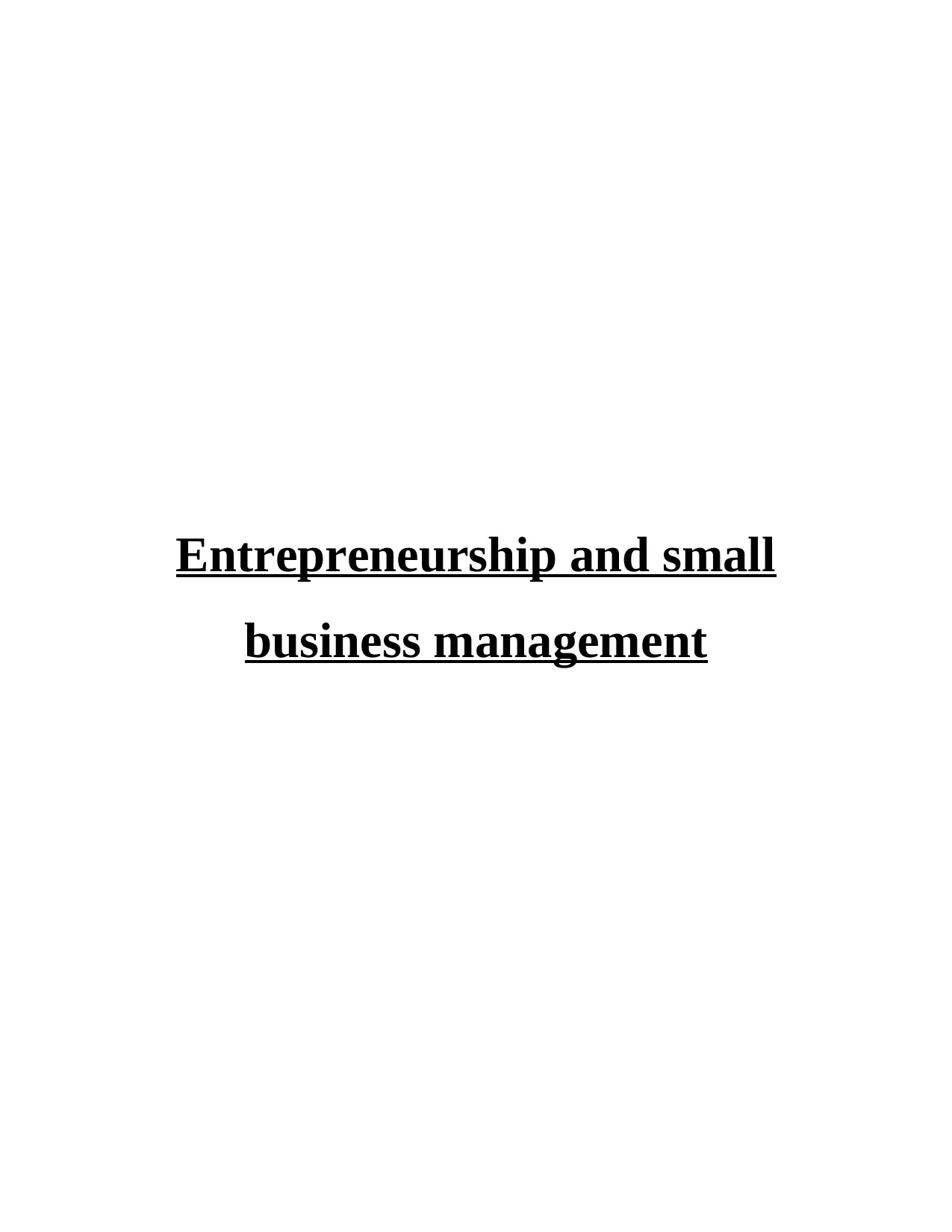
Entrepreneurship and small
business management
business management
Secure Best Marks with AI Grader
Need help grading? Try our AI Grader for instant feedback on your assignments.
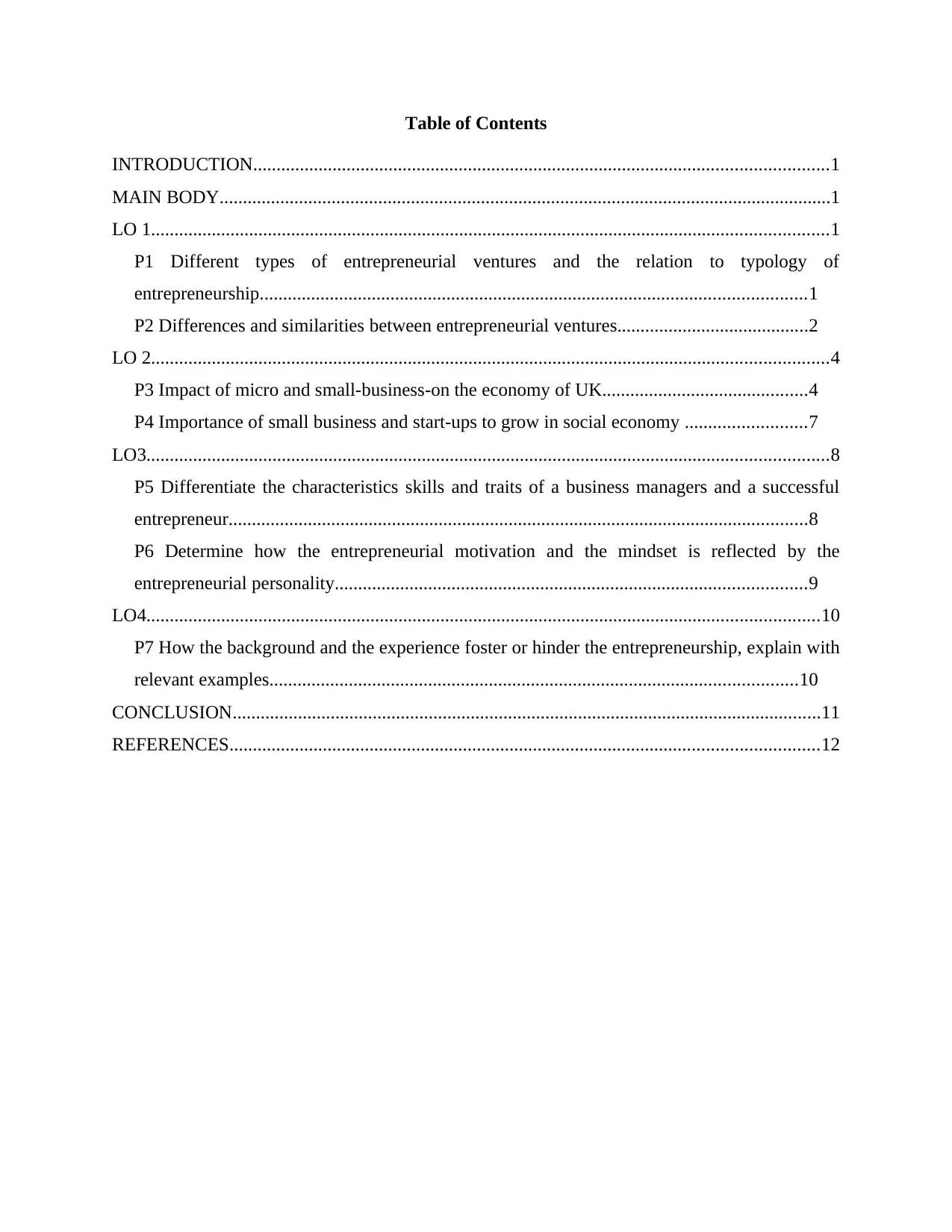
Table of Contents
INTRODUCTION...........................................................................................................................1
MAIN BODY...................................................................................................................................1
LO 1.................................................................................................................................................1
P1 Different types of entrepreneurial ventures and the relation to typology of
entrepreneurship.....................................................................................................................1
P2 Differences and similarities between entrepreneurial ventures.........................................2
LO 2.................................................................................................................................................4
P3 Impact of micro and small-business-on the economy of UK............................................4
P4 Importance of small business and start-ups to grow in social economy ..........................7
LO3..................................................................................................................................................8
P5 Differentiate the characteristics skills and traits of a business managers and a successful
entrepreneur............................................................................................................................8
P6 Determine how the entrepreneurial motivation and the mindset is reflected by the
entrepreneurial personality.....................................................................................................9
LO4................................................................................................................................................10
P7 How the background and the experience foster or hinder the entrepreneurship, explain with
relevant examples.................................................................................................................10
CONCLUSION..............................................................................................................................11
REFERENCES..............................................................................................................................12
INTRODUCTION...........................................................................................................................1
MAIN BODY...................................................................................................................................1
LO 1.................................................................................................................................................1
P1 Different types of entrepreneurial ventures and the relation to typology of
entrepreneurship.....................................................................................................................1
P2 Differences and similarities between entrepreneurial ventures.........................................2
LO 2.................................................................................................................................................4
P3 Impact of micro and small-business-on the economy of UK............................................4
P4 Importance of small business and start-ups to grow in social economy ..........................7
LO3..................................................................................................................................................8
P5 Differentiate the characteristics skills and traits of a business managers and a successful
entrepreneur............................................................................................................................8
P6 Determine how the entrepreneurial motivation and the mindset is reflected by the
entrepreneurial personality.....................................................................................................9
LO4................................................................................................................................................10
P7 How the background and the experience foster or hinder the entrepreneurship, explain with
relevant examples.................................................................................................................10
CONCLUSION..............................................................................................................................11
REFERENCES..............................................................................................................................12
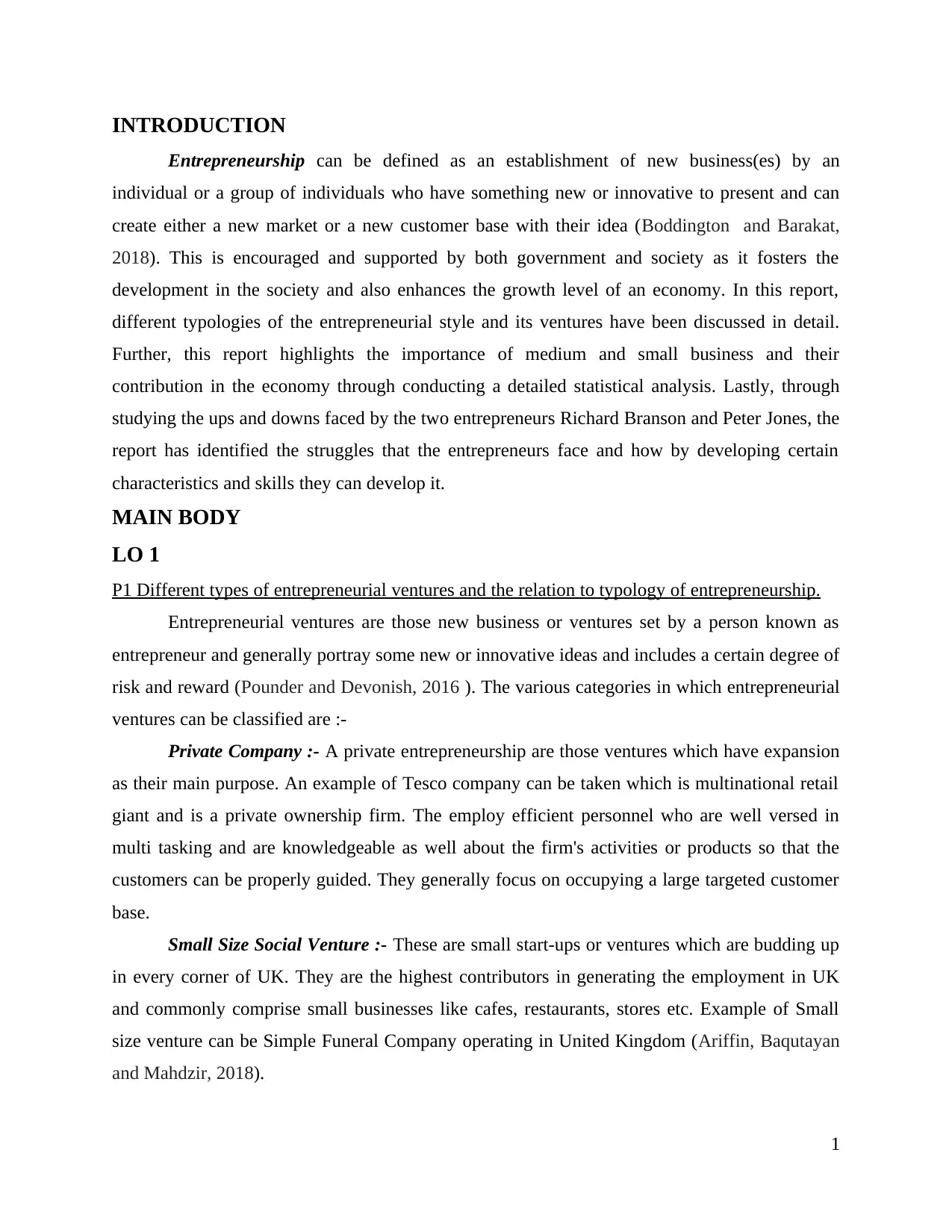
INTRODUCTION
Entrepreneurship can be defined as an establishment of new business(es) by an
individual or a group of individuals who have something new or innovative to present and can
create either a new market or a new customer base with their idea (Boddington and Barakat,
2018). This is encouraged and supported by both government and society as it fosters the
development in the society and also enhances the growth level of an economy. In this report,
different typologies of the entrepreneurial style and its ventures have been discussed in detail.
Further, this report highlights the importance of medium and small business and their
contribution in the economy through conducting a detailed statistical analysis. Lastly, through
studying the ups and downs faced by the two entrepreneurs Richard Branson and Peter Jones, the
report has identified the struggles that the entrepreneurs face and how by developing certain
characteristics and skills they can develop it.
MAIN BODY
LO 1
P1 Different types of entrepreneurial ventures and the relation to typology of entrepreneurship.
Entrepreneurial ventures are those new business or ventures set by a person known as
entrepreneur and generally portray some new or innovative ideas and includes a certain degree of
risk and reward (Pounder and Devonish, 2016 ). The various categories in which entrepreneurial
ventures can be classified are :-
Private Company :- A private entrepreneurship are those ventures which have expansion
as their main purpose. An example of Tesco company can be taken which is multinational retail
giant and is a private ownership firm. The employ efficient personnel who are well versed in
multi tasking and are knowledgeable as well about the firm's activities or products so that the
customers can be properly guided. They generally focus on occupying a large targeted customer
base.
Small Size Social Venture :- These are small start-ups or ventures which are budding up
in every corner of UK. They are the highest contributors in generating the employment in UK
and commonly comprise small businesses like cafes, restaurants, stores etc. Example of Small
size venture can be Simple Funeral Company operating in United Kingdom (Ariffin, Baqutayan
and Mahdzir, 2018).
1
Entrepreneurship can be defined as an establishment of new business(es) by an
individual or a group of individuals who have something new or innovative to present and can
create either a new market or a new customer base with their idea (Boddington and Barakat,
2018). This is encouraged and supported by both government and society as it fosters the
development in the society and also enhances the growth level of an economy. In this report,
different typologies of the entrepreneurial style and its ventures have been discussed in detail.
Further, this report highlights the importance of medium and small business and their
contribution in the economy through conducting a detailed statistical analysis. Lastly, through
studying the ups and downs faced by the two entrepreneurs Richard Branson and Peter Jones, the
report has identified the struggles that the entrepreneurs face and how by developing certain
characteristics and skills they can develop it.
MAIN BODY
LO 1
P1 Different types of entrepreneurial ventures and the relation to typology of entrepreneurship.
Entrepreneurial ventures are those new business or ventures set by a person known as
entrepreneur and generally portray some new or innovative ideas and includes a certain degree of
risk and reward (Pounder and Devonish, 2016 ). The various categories in which entrepreneurial
ventures can be classified are :-
Private Company :- A private entrepreneurship are those ventures which have expansion
as their main purpose. An example of Tesco company can be taken which is multinational retail
giant and is a private ownership firm. The employ efficient personnel who are well versed in
multi tasking and are knowledgeable as well about the firm's activities or products so that the
customers can be properly guided. They generally focus on occupying a large targeted customer
base.
Small Size Social Venture :- These are small start-ups or ventures which are budding up
in every corner of UK. They are the highest contributors in generating the employment in UK
and commonly comprise small businesses like cafes, restaurants, stores etc. Example of Small
size venture can be Simple Funeral Company operating in United Kingdom (Ariffin, Baqutayan
and Mahdzir, 2018).
1
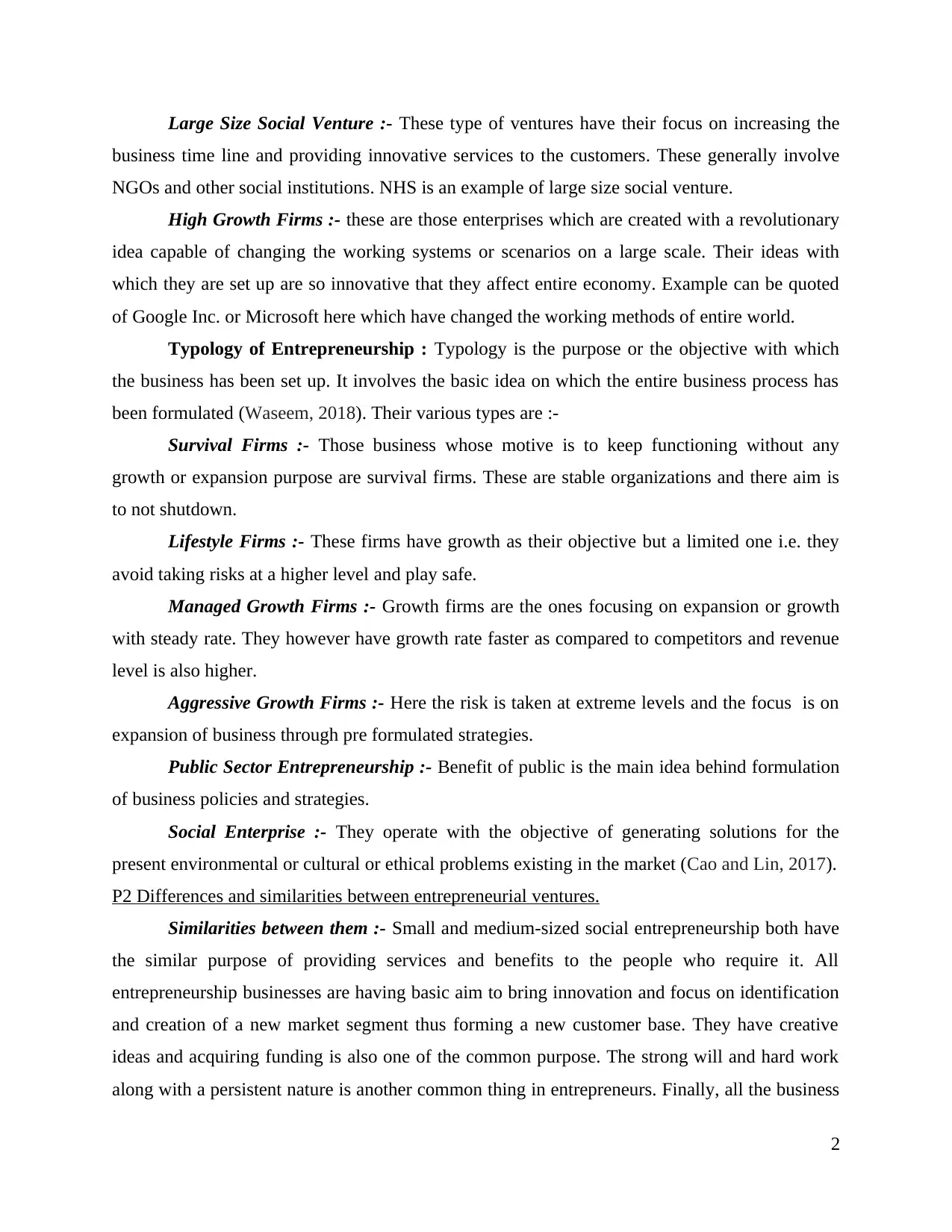
Large Size Social Venture :- These type of ventures have their focus on increasing the
business time line and providing innovative services to the customers. These generally involve
NGOs and other social institutions. NHS is an example of large size social venture.
High Growth Firms :- these are those enterprises which are created with a revolutionary
idea capable of changing the working systems or scenarios on a large scale. Their ideas with
which they are set up are so innovative that they affect entire economy. Example can be quoted
of Google Inc. or Microsoft here which have changed the working methods of entire world.
Typology of Entrepreneurship : Typology is the purpose or the objective with which
the business has been set up. It involves the basic idea on which the entire business process has
been formulated (Waseem, 2018). Their various types are :-
Survival Firms :- Those business whose motive is to keep functioning without any
growth or expansion purpose are survival firms. These are stable organizations and there aim is
to not shutdown.
Lifestyle Firms :- These firms have growth as their objective but a limited one i.e. they
avoid taking risks at a higher level and play safe.
Managed Growth Firms :- Growth firms are the ones focusing on expansion or growth
with steady rate. They however have growth rate faster as compared to competitors and revenue
level is also higher.
Aggressive Growth Firms :- Here the risk is taken at extreme levels and the focus is on
expansion of business through pre formulated strategies.
Public Sector Entrepreneurship :- Benefit of public is the main idea behind formulation
of business policies and strategies.
Social Enterprise :- They operate with the objective of generating solutions for the
present environmental or cultural or ethical problems existing in the market (Cao and Lin, 2017).
P2 Differences and similarities between entrepreneurial ventures.
Similarities between them :- Small and medium-sized social entrepreneurship both have
the similar purpose of providing services and benefits to the people who require it. All
entrepreneurship businesses are having basic aim to bring innovation and focus on identification
and creation of a new market segment thus forming a new customer base. They have creative
ideas and acquiring funding is also one of the common purpose. The strong will and hard work
along with a persistent nature is another common thing in entrepreneurs. Finally, all the business
2
business time line and providing innovative services to the customers. These generally involve
NGOs and other social institutions. NHS is an example of large size social venture.
High Growth Firms :- these are those enterprises which are created with a revolutionary
idea capable of changing the working systems or scenarios on a large scale. Their ideas with
which they are set up are so innovative that they affect entire economy. Example can be quoted
of Google Inc. or Microsoft here which have changed the working methods of entire world.
Typology of Entrepreneurship : Typology is the purpose or the objective with which
the business has been set up. It involves the basic idea on which the entire business process has
been formulated (Waseem, 2018). Their various types are :-
Survival Firms :- Those business whose motive is to keep functioning without any
growth or expansion purpose are survival firms. These are stable organizations and there aim is
to not shutdown.
Lifestyle Firms :- These firms have growth as their objective but a limited one i.e. they
avoid taking risks at a higher level and play safe.
Managed Growth Firms :- Growth firms are the ones focusing on expansion or growth
with steady rate. They however have growth rate faster as compared to competitors and revenue
level is also higher.
Aggressive Growth Firms :- Here the risk is taken at extreme levels and the focus is on
expansion of business through pre formulated strategies.
Public Sector Entrepreneurship :- Benefit of public is the main idea behind formulation
of business policies and strategies.
Social Enterprise :- They operate with the objective of generating solutions for the
present environmental or cultural or ethical problems existing in the market (Cao and Lin, 2017).
P2 Differences and similarities between entrepreneurial ventures.
Similarities between them :- Small and medium-sized social entrepreneurship both have
the similar purpose of providing services and benefits to the people who require it. All
entrepreneurship businesses are having basic aim to bring innovation and focus on identification
and creation of a new market segment thus forming a new customer base. They have creative
ideas and acquiring funding is also one of the common purpose. The strong will and hard work
along with a persistent nature is another common thing in entrepreneurs. Finally, all the business
2
Secure Best Marks with AI Grader
Need help grading? Try our AI Grader for instant feedback on your assignments.
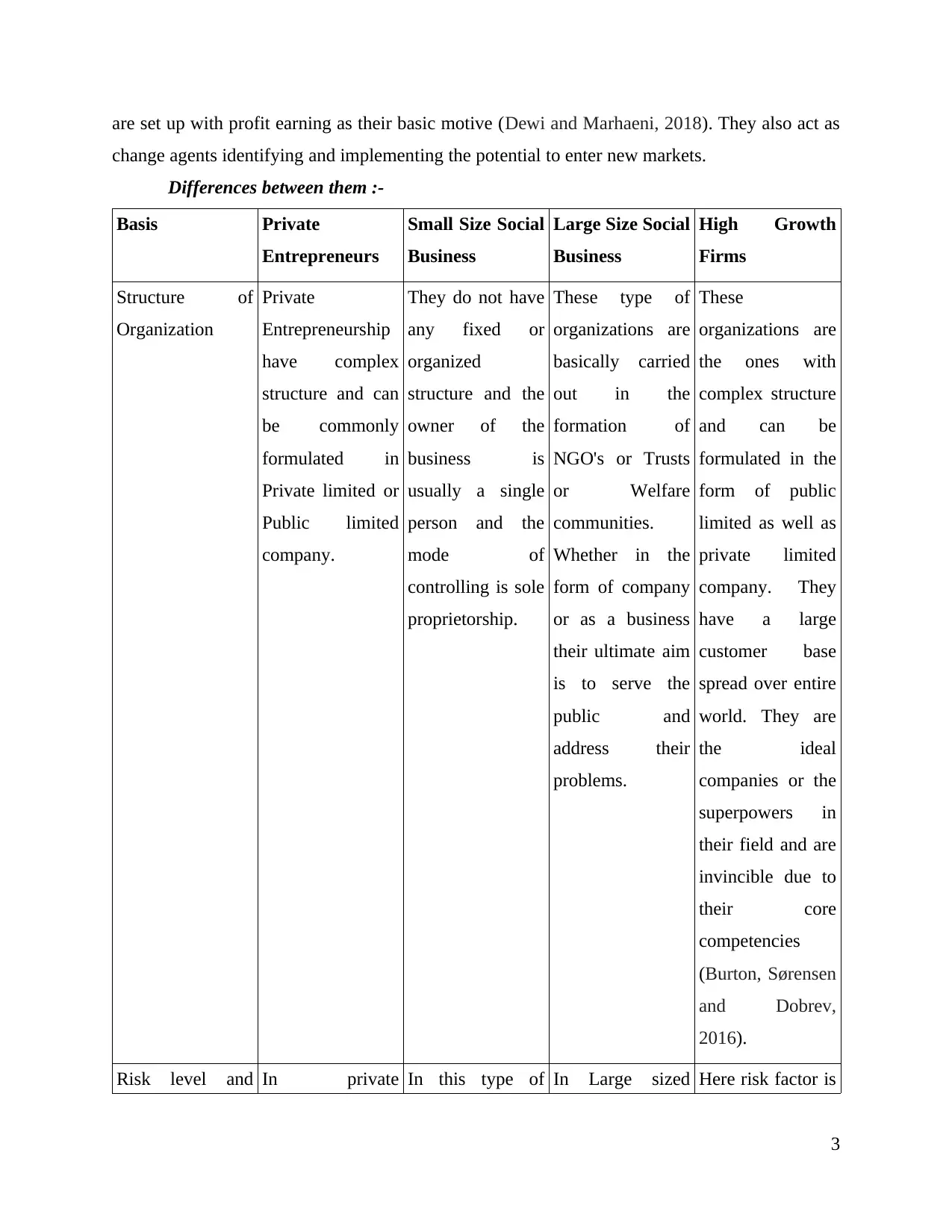
are set up with profit earning as their basic motive (Dewi and Marhaeni, 2018). They also act as
change agents identifying and implementing the potential to enter new markets.
Differences between them :-
Basis Private
Entrepreneurs
Small Size Social
Business
Large Size Social
Business
High Growth
Firms
Structure of
Organization
Private
Entrepreneurship
have complex
structure and can
be commonly
formulated in
Private limited or
Public limited
company.
They do not have
any fixed or
organized
structure and the
owner of the
business is
usually a single
person and the
mode of
controlling is sole
proprietorship.
These type of
organizations are
basically carried
out in the
formation of
NGO's or Trusts
or Welfare
communities.
Whether in the
form of company
or as a business
their ultimate aim
is to serve the
public and
address their
problems.
These
organizations are
the ones with
complex structure
and can be
formulated in the
form of public
limited as well as
private limited
company. They
have a large
customer base
spread over entire
world. They are
the ideal
companies or the
superpowers in
their field and are
invincible due to
their core
competencies
(Burton, Sørensen
and Dobrev,
2016).
Risk level and In private In this type of In Large sized Here risk factor is
3
change agents identifying and implementing the potential to enter new markets.
Differences between them :-
Basis Private
Entrepreneurs
Small Size Social
Business
Large Size Social
Business
High Growth
Firms
Structure of
Organization
Private
Entrepreneurship
have complex
structure and can
be commonly
formulated in
Private limited or
Public limited
company.
They do not have
any fixed or
organized
structure and the
owner of the
business is
usually a single
person and the
mode of
controlling is sole
proprietorship.
These type of
organizations are
basically carried
out in the
formation of
NGO's or Trusts
or Welfare
communities.
Whether in the
form of company
or as a business
their ultimate aim
is to serve the
public and
address their
problems.
These
organizations are
the ones with
complex structure
and can be
formulated in the
form of public
limited as well as
private limited
company. They
have a large
customer base
spread over entire
world. They are
the ideal
companies or the
superpowers in
their field and are
invincible due to
their core
competencies
(Burton, Sørensen
and Dobrev,
2016).
Risk level and In private In this type of In Large sized Here risk factor is
3
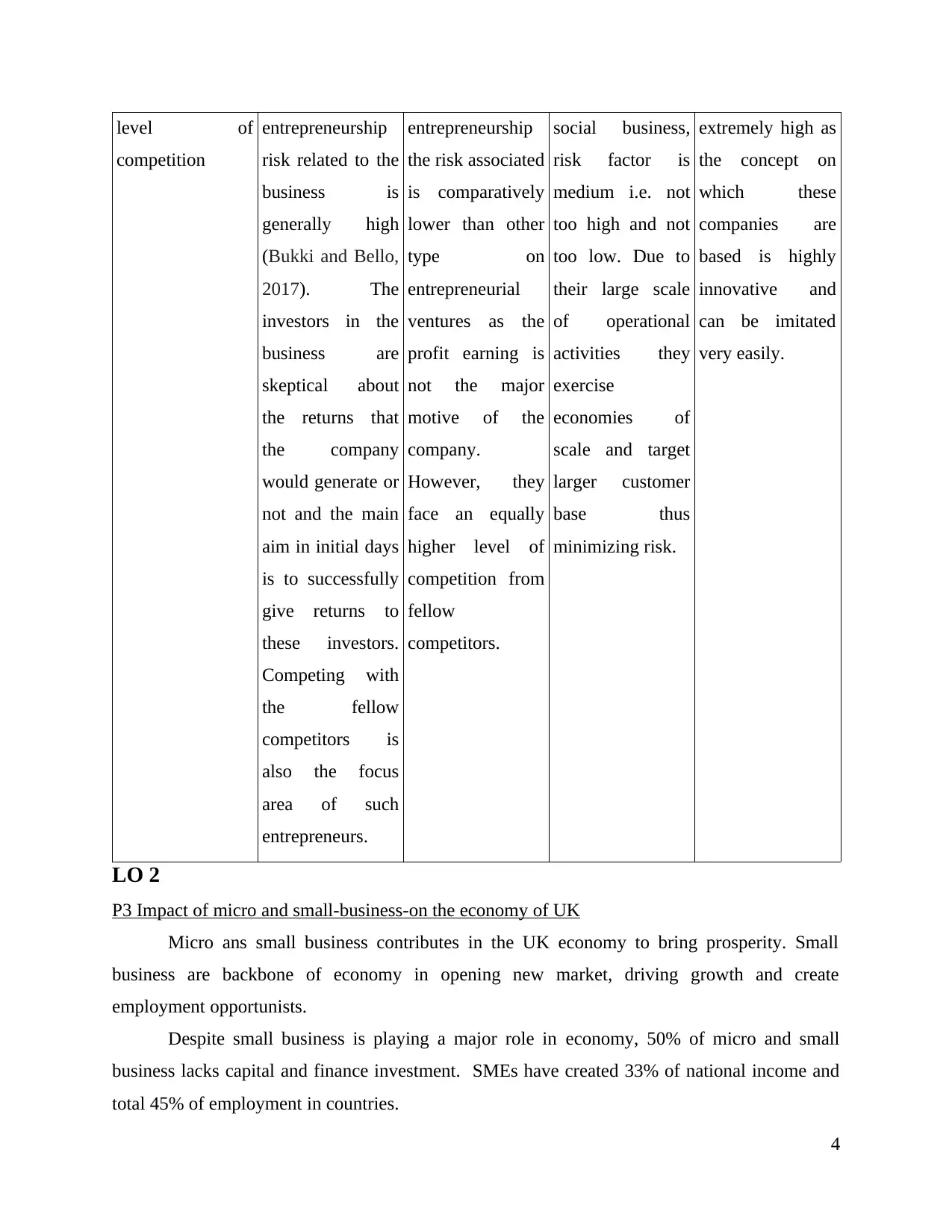
level of
competition
entrepreneurship
risk related to the
business is
generally high
(Bukki and Bello,
2017). The
investors in the
business are
skeptical about
the returns that
the company
would generate or
not and the main
aim in initial days
is to successfully
give returns to
these investors.
Competing with
the fellow
competitors is
also the focus
area of such
entrepreneurs.
entrepreneurship
the risk associated
is comparatively
lower than other
type on
entrepreneurial
ventures as the
profit earning is
not the major
motive of the
company.
However, they
face an equally
higher level of
competition from
fellow
competitors.
social business,
risk factor is
medium i.e. not
too high and not
too low. Due to
their large scale
of operational
activities they
exercise
economies of
scale and target
larger customer
base thus
minimizing risk.
extremely high as
the concept on
which these
companies are
based is highly
innovative and
can be imitated
very easily.
LO 2
P3 Impact of micro and small-business-on the economy of UK
Micro ans small business contributes in the UK economy to bring prosperity. Small
business are backbone of economy in opening new market, driving growth and create
employment opportunists.
Despite small business is playing a major role in economy, 50% of micro and small
business lacks capital and finance investment. SMEs have created 33% of national income and
total 45% of employment in countries.
4
competition
entrepreneurship
risk related to the
business is
generally high
(Bukki and Bello,
2017). The
investors in the
business are
skeptical about
the returns that
the company
would generate or
not and the main
aim in initial days
is to successfully
give returns to
these investors.
Competing with
the fellow
competitors is
also the focus
area of such
entrepreneurs.
entrepreneurship
the risk associated
is comparatively
lower than other
type on
entrepreneurial
ventures as the
profit earning is
not the major
motive of the
company.
However, they
face an equally
higher level of
competition from
fellow
competitors.
social business,
risk factor is
medium i.e. not
too high and not
too low. Due to
their large scale
of operational
activities they
exercise
economies of
scale and target
larger customer
base thus
minimizing risk.
extremely high as
the concept on
which these
companies are
based is highly
innovative and
can be imitated
very easily.
LO 2
P3 Impact of micro and small-business-on the economy of UK
Micro ans small business contributes in the UK economy to bring prosperity. Small
business are backbone of economy in opening new market, driving growth and create
employment opportunists.
Despite small business is playing a major role in economy, 50% of micro and small
business lacks capital and finance investment. SMEs have created 33% of national income and
total 45% of employment in countries.
4
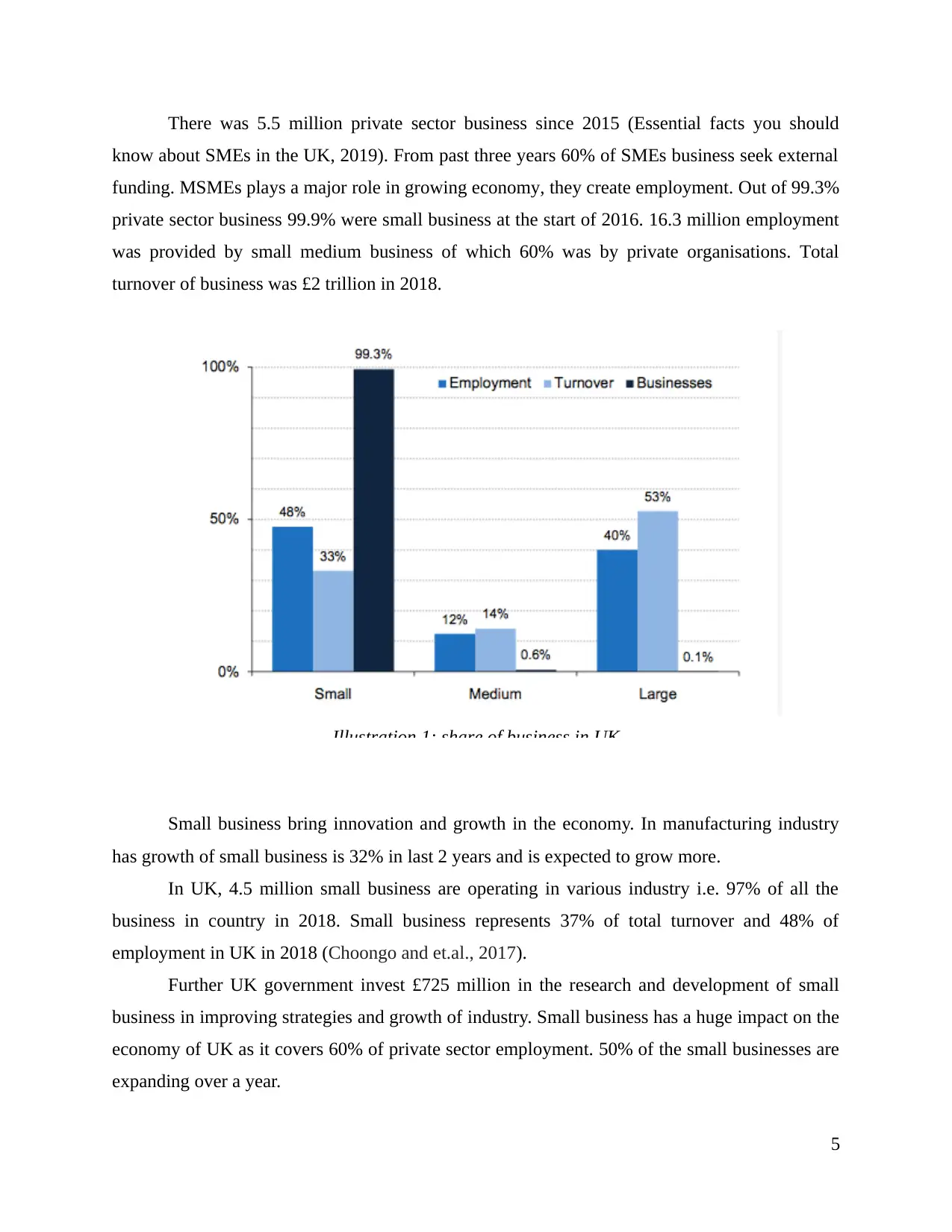
There was 5.5 million private sector business since 2015 (Essential facts you should
know about SMEs in the UK, 2019). From past three years 60% of SMEs business seek external
funding. MSMEs plays a major role in growing economy, they create employment. Out of 99.3%
private sector business 99.9% were small business at the start of 2016. 16.3 million employment
was provided by small medium business of which 60% was by private organisations. Total
turnover of business was £2 trillion in 2018.
Small business bring innovation and growth in the economy. In manufacturing industry
has growth of small business is 32% in last 2 years and is expected to grow more.
In UK, 4.5 million small business are operating in various industry i.e. 97% of all the
business in country in 2018. Small business represents 37% of total turnover and 48% of
employment in UK in 2018 (Choongo and et.al., 2017).
Further UK government invest £725 million in the research and development of small
business in improving strategies and growth of industry. Small business has a huge impact on the
economy of UK as it covers 60% of private sector employment. 50% of the small businesses are
expanding over a year.
5
Illustration 1: share of business in UK
know about SMEs in the UK, 2019). From past three years 60% of SMEs business seek external
funding. MSMEs plays a major role in growing economy, they create employment. Out of 99.3%
private sector business 99.9% were small business at the start of 2016. 16.3 million employment
was provided by small medium business of which 60% was by private organisations. Total
turnover of business was £2 trillion in 2018.
Small business bring innovation and growth in the economy. In manufacturing industry
has growth of small business is 32% in last 2 years and is expected to grow more.
In UK, 4.5 million small business are operating in various industry i.e. 97% of all the
business in country in 2018. Small business represents 37% of total turnover and 48% of
employment in UK in 2018 (Choongo and et.al., 2017).
Further UK government invest £725 million in the research and development of small
business in improving strategies and growth of industry. Small business has a huge impact on the
economy of UK as it covers 60% of private sector employment. 50% of the small businesses are
expanding over a year.
5
Illustration 1: share of business in UK
Paraphrase This Document
Need a fresh take? Get an instant paraphrase of this document with our AI Paraphraser
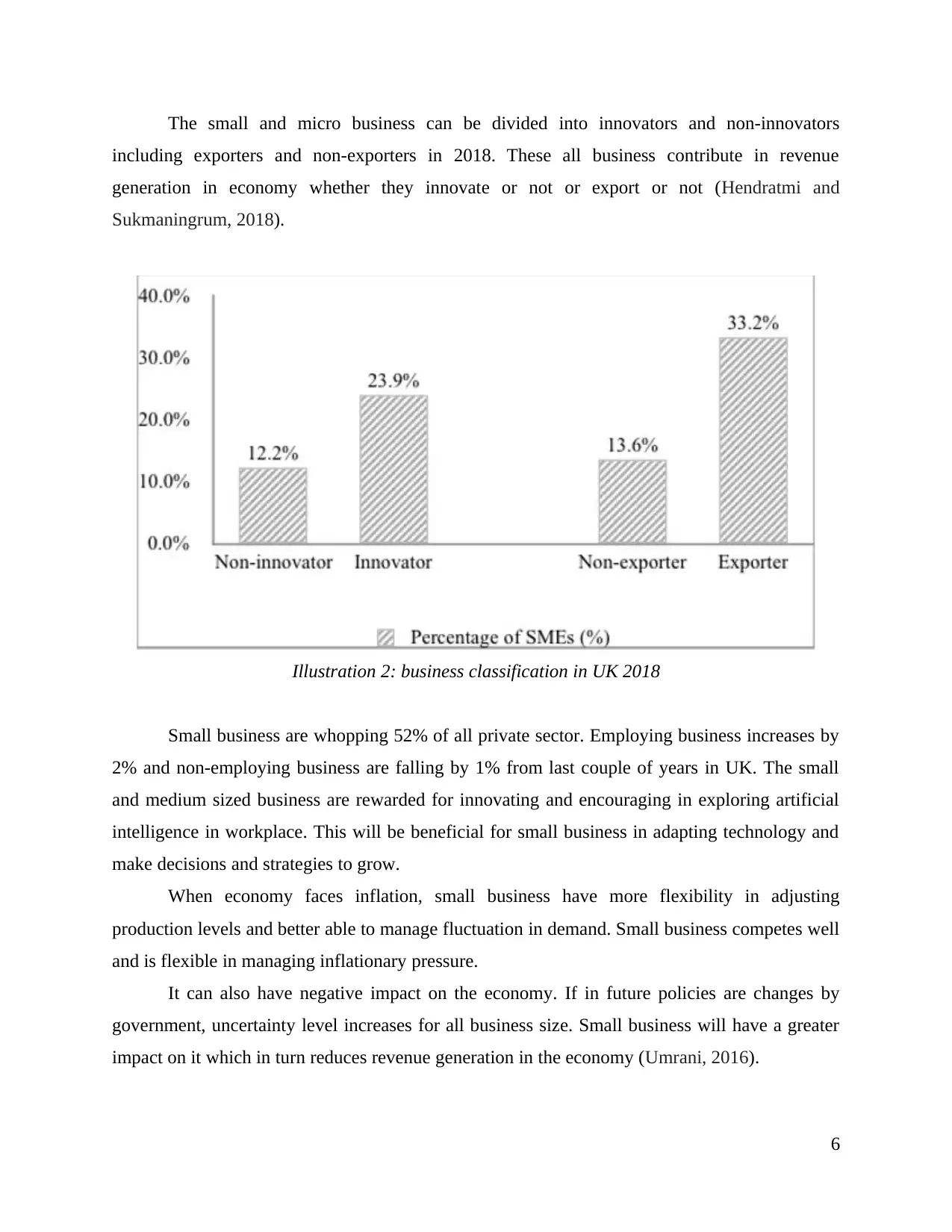
The small and micro business can be divided into innovators and non-innovators
including exporters and non-exporters in 2018. These all business contribute in revenue
generation in economy whether they innovate or not or export or not (Hendratmi and
Sukmaningrum, 2018).
Small business are whopping 52% of all private sector. Employing business increases by
2% and non-employing business are falling by 1% from last couple of years in UK. The small
and medium sized business are rewarded for innovating and encouraging in exploring artificial
intelligence in workplace. This will be beneficial for small business in adapting technology and
make decisions and strategies to grow.
When economy faces inflation, small business have more flexibility in adjusting
production levels and better able to manage fluctuation in demand. Small business competes well
and is flexible in managing inflationary pressure.
It can also have negative impact on the economy. If in future policies are changes by
government, uncertainty level increases for all business size. Small business will have a greater
impact on it which in turn reduces revenue generation in the economy (Umrani, 2016).
6
Illustration 2: business classification in UK 2018
including exporters and non-exporters in 2018. These all business contribute in revenue
generation in economy whether they innovate or not or export or not (Hendratmi and
Sukmaningrum, 2018).
Small business are whopping 52% of all private sector. Employing business increases by
2% and non-employing business are falling by 1% from last couple of years in UK. The small
and medium sized business are rewarded for innovating and encouraging in exploring artificial
intelligence in workplace. This will be beneficial for small business in adapting technology and
make decisions and strategies to grow.
When economy faces inflation, small business have more flexibility in adjusting
production levels and better able to manage fluctuation in demand. Small business competes well
and is flexible in managing inflationary pressure.
It can also have negative impact on the economy. If in future policies are changes by
government, uncertainty level increases for all business size. Small business will have a greater
impact on it which in turn reduces revenue generation in the economy (Umrani, 2016).
6
Illustration 2: business classification in UK 2018
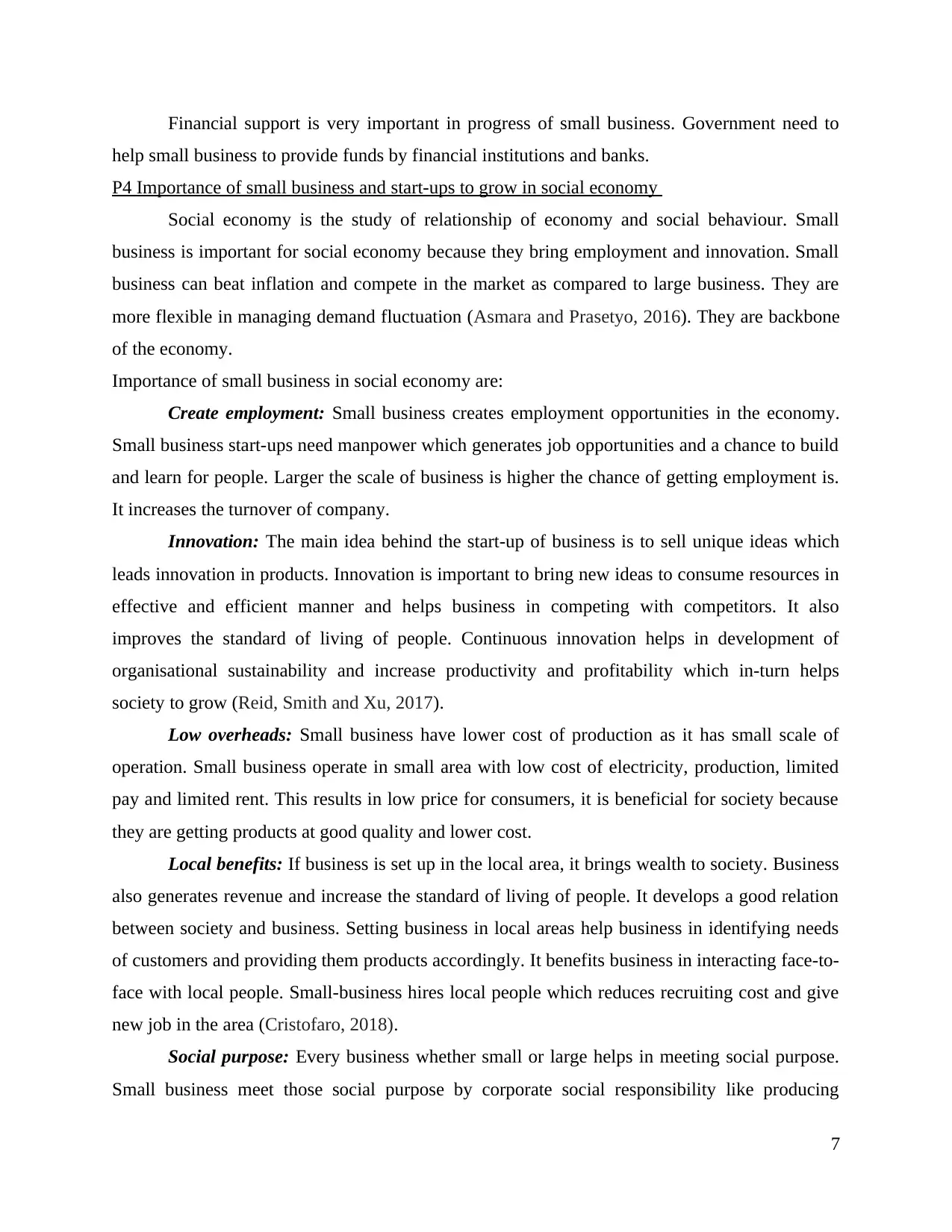
Financial support is very important in progress of small business. Government need to
help small business to provide funds by financial institutions and banks.
P4 Importance of small business and start-ups to grow in social economy
Social economy is the study of relationship of economy and social behaviour. Small
business is important for social economy because they bring employment and innovation. Small
business can beat inflation and compete in the market as compared to large business. They are
more flexible in managing demand fluctuation (Asmara and Prasetyo, 2016). They are backbone
of the economy.
Importance of small business in social economy are:
Create employment: Small business creates employment opportunities in the economy.
Small business start-ups need manpower which generates job opportunities and a chance to build
and learn for people. Larger the scale of business is higher the chance of getting employment is.
It increases the turnover of company.
Innovation: The main idea behind the start-up of business is to sell unique ideas which
leads innovation in products. Innovation is important to bring new ideas to consume resources in
effective and efficient manner and helps business in competing with competitors. It also
improves the standard of living of people. Continuous innovation helps in development of
organisational sustainability and increase productivity and profitability which in-turn helps
society to grow (Reid, Smith and Xu, 2017).
Low overheads: Small business have lower cost of production as it has small scale of
operation. Small business operate in small area with low cost of electricity, production, limited
pay and limited rent. This results in low price for consumers, it is beneficial for society because
they are getting products at good quality and lower cost.
Local benefits: If business is set up in the local area, it brings wealth to society. Business
also generates revenue and increase the standard of living of people. It develops a good relation
between society and business. Setting business in local areas help business in identifying needs
of customers and providing them products accordingly. It benefits business in interacting face-to-
face with local people. Small-business hires local people which reduces recruiting cost and give
new job in the area (Cristofaro, 2018).
Social purpose: Every business whether small or large helps in meeting social purpose.
Small business meet those social purpose by corporate social responsibility like producing
7
help small business to provide funds by financial institutions and banks.
P4 Importance of small business and start-ups to grow in social economy
Social economy is the study of relationship of economy and social behaviour. Small
business is important for social economy because they bring employment and innovation. Small
business can beat inflation and compete in the market as compared to large business. They are
more flexible in managing demand fluctuation (Asmara and Prasetyo, 2016). They are backbone
of the economy.
Importance of small business in social economy are:
Create employment: Small business creates employment opportunities in the economy.
Small business start-ups need manpower which generates job opportunities and a chance to build
and learn for people. Larger the scale of business is higher the chance of getting employment is.
It increases the turnover of company.
Innovation: The main idea behind the start-up of business is to sell unique ideas which
leads innovation in products. Innovation is important to bring new ideas to consume resources in
effective and efficient manner and helps business in competing with competitors. It also
improves the standard of living of people. Continuous innovation helps in development of
organisational sustainability and increase productivity and profitability which in-turn helps
society to grow (Reid, Smith and Xu, 2017).
Low overheads: Small business have lower cost of production as it has small scale of
operation. Small business operate in small area with low cost of electricity, production, limited
pay and limited rent. This results in low price for consumers, it is beneficial for society because
they are getting products at good quality and lower cost.
Local benefits: If business is set up in the local area, it brings wealth to society. Business
also generates revenue and increase the standard of living of people. It develops a good relation
between society and business. Setting business in local areas help business in identifying needs
of customers and providing them products accordingly. It benefits business in interacting face-to-
face with local people. Small-business hires local people which reduces recruiting cost and give
new job in the area (Cristofaro, 2018).
Social purpose: Every business whether small or large helps in meeting social purpose.
Small business meet those social purpose by corporate social responsibility like producing
7
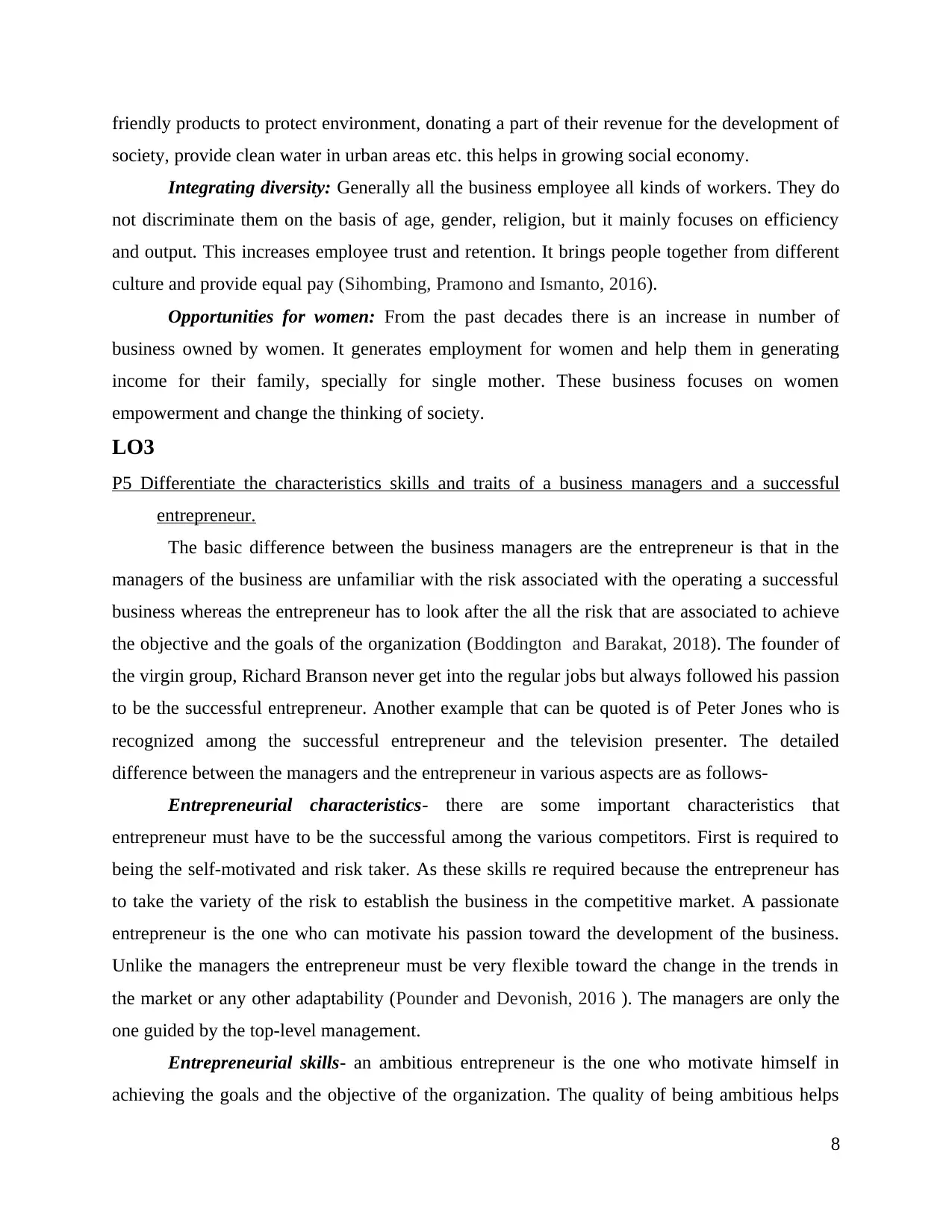
friendly products to protect environment, donating a part of their revenue for the development of
society, provide clean water in urban areas etc. this helps in growing social economy.
Integrating diversity: Generally all the business employee all kinds of workers. They do
not discriminate them on the basis of age, gender, religion, but it mainly focuses on efficiency
and output. This increases employee trust and retention. It brings people together from different
culture and provide equal pay (Sihombing, Pramono and Ismanto, 2016).
Opportunities for women: From the past decades there is an increase in number of
business owned by women. It generates employment for women and help them in generating
income for their family, specially for single mother. These business focuses on women
empowerment and change the thinking of society.
LO3
P5 Differentiate the characteristics skills and traits of a business managers and a successful
entrepreneur.
The basic difference between the business managers are the entrepreneur is that in the
managers of the business are unfamiliar with the risk associated with the operating a successful
business whereas the entrepreneur has to look after the all the risk that are associated to achieve
the objective and the goals of the organization (Boddington and Barakat, 2018). The founder of
the virgin group, Richard Branson never get into the regular jobs but always followed his passion
to be the successful entrepreneur. Another example that can be quoted is of Peter Jones who is
recognized among the successful entrepreneur and the television presenter. The detailed
difference between the managers and the entrepreneur in various aspects are as follows-
Entrepreneurial characteristics- there are some important characteristics that
entrepreneur must have to be the successful among the various competitors. First is required to
being the self-motivated and risk taker. As these skills re required because the entrepreneur has
to take the variety of the risk to establish the business in the competitive market. A passionate
entrepreneur is the one who can motivate his passion toward the development of the business.
Unlike the managers the entrepreneur must be very flexible toward the change in the trends in
the market or any other adaptability (Pounder and Devonish, 2016 ). The managers are only the
one guided by the top-level management.
Entrepreneurial skills- an ambitious entrepreneur is the one who motivate himself in
achieving the goals and the objective of the organization. The quality of being ambitious helps
8
society, provide clean water in urban areas etc. this helps in growing social economy.
Integrating diversity: Generally all the business employee all kinds of workers. They do
not discriminate them on the basis of age, gender, religion, but it mainly focuses on efficiency
and output. This increases employee trust and retention. It brings people together from different
culture and provide equal pay (Sihombing, Pramono and Ismanto, 2016).
Opportunities for women: From the past decades there is an increase in number of
business owned by women. It generates employment for women and help them in generating
income for their family, specially for single mother. These business focuses on women
empowerment and change the thinking of society.
LO3
P5 Differentiate the characteristics skills and traits of a business managers and a successful
entrepreneur.
The basic difference between the business managers are the entrepreneur is that in the
managers of the business are unfamiliar with the risk associated with the operating a successful
business whereas the entrepreneur has to look after the all the risk that are associated to achieve
the objective and the goals of the organization (Boddington and Barakat, 2018). The founder of
the virgin group, Richard Branson never get into the regular jobs but always followed his passion
to be the successful entrepreneur. Another example that can be quoted is of Peter Jones who is
recognized among the successful entrepreneur and the television presenter. The detailed
difference between the managers and the entrepreneur in various aspects are as follows-
Entrepreneurial characteristics- there are some important characteristics that
entrepreneur must have to be the successful among the various competitors. First is required to
being the self-motivated and risk taker. As these skills re required because the entrepreneur has
to take the variety of the risk to establish the business in the competitive market. A passionate
entrepreneur is the one who can motivate his passion toward the development of the business.
Unlike the managers the entrepreneur must be very flexible toward the change in the trends in
the market or any other adaptability (Pounder and Devonish, 2016 ). The managers are only the
one guided by the top-level management.
Entrepreneurial skills- an ambitious entrepreneur is the one who motivate himself in
achieving the goals and the objective of the organization. The quality of being ambitious helps
8
Secure Best Marks with AI Grader
Need help grading? Try our AI Grader for instant feedback on your assignments.
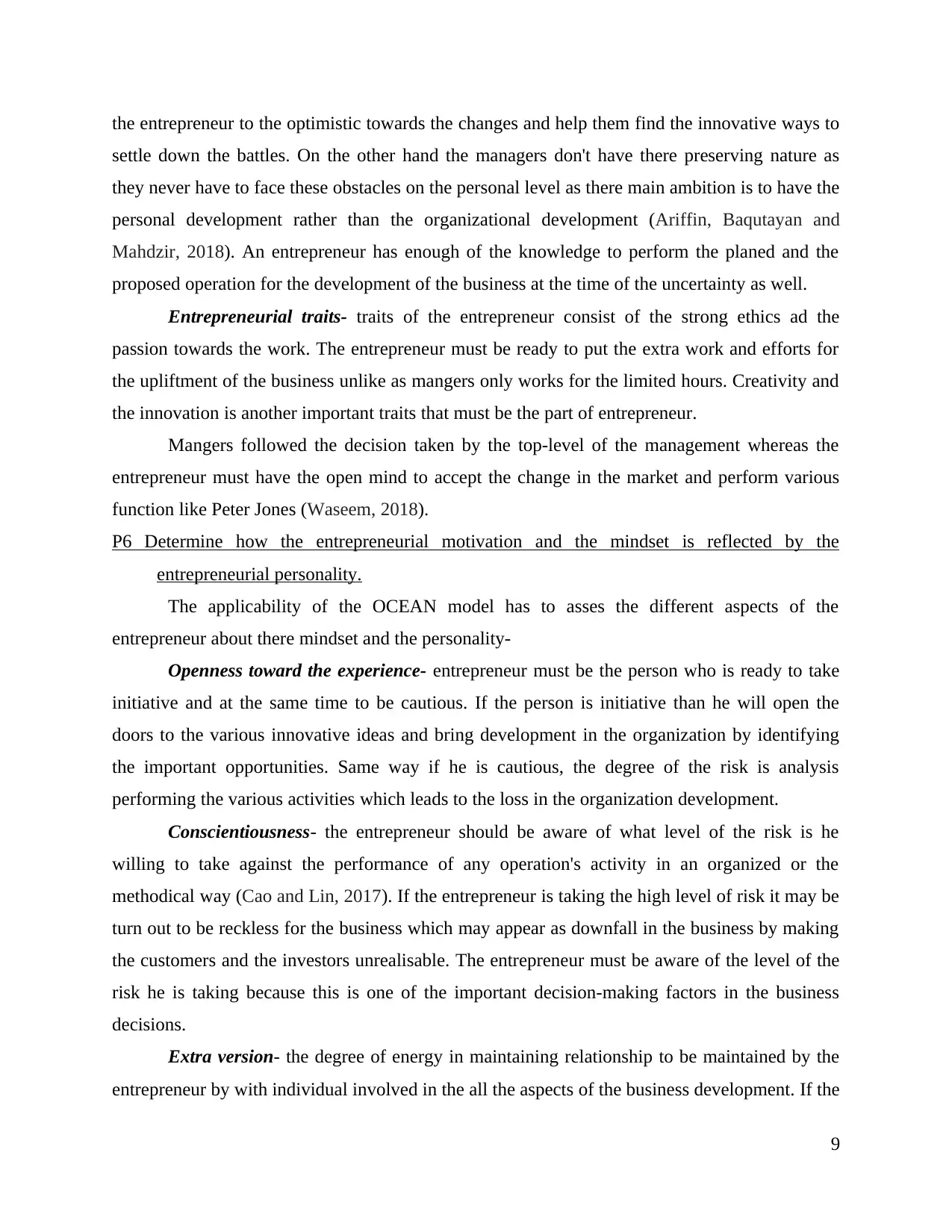
the entrepreneur to the optimistic towards the changes and help them find the innovative ways to
settle down the battles. On the other hand the managers don't have there preserving nature as
they never have to face these obstacles on the personal level as there main ambition is to have the
personal development rather than the organizational development (Ariffin, Baqutayan and
Mahdzir, 2018). An entrepreneur has enough of the knowledge to perform the planed and the
proposed operation for the development of the business at the time of the uncertainty as well.
Entrepreneurial traits- traits of the entrepreneur consist of the strong ethics ad the
passion towards the work. The entrepreneur must be ready to put the extra work and efforts for
the upliftment of the business unlike as mangers only works for the limited hours. Creativity and
the innovation is another important traits that must be the part of entrepreneur.
Mangers followed the decision taken by the top-level of the management whereas the
entrepreneur must have the open mind to accept the change in the market and perform various
function like Peter Jones (Waseem, 2018).
P6 Determine how the entrepreneurial motivation and the mindset is reflected by the
entrepreneurial personality.
The applicability of the OCEAN model has to asses the different aspects of the
entrepreneur about there mindset and the personality-
Openness toward the experience- entrepreneur must be the person who is ready to take
initiative and at the same time to be cautious. If the person is initiative than he will open the
doors to the various innovative ideas and bring development in the organization by identifying
the important opportunities. Same way if he is cautious, the degree of the risk is analysis
performing the various activities which leads to the loss in the organization development.
Conscientiousness- the entrepreneur should be aware of what level of the risk is he
willing to take against the performance of any operation's activity in an organized or the
methodical way (Cao and Lin, 2017). If the entrepreneur is taking the high level of risk it may be
turn out to be reckless for the business which may appear as downfall in the business by making
the customers and the investors unrealisable. The entrepreneur must be aware of the level of the
risk he is taking because this is one of the important decision-making factors in the business
decisions.
Extra version- the degree of energy in maintaining relationship to be maintained by the
entrepreneur by with individual involved in the all the aspects of the business development. If the
9
settle down the battles. On the other hand the managers don't have there preserving nature as
they never have to face these obstacles on the personal level as there main ambition is to have the
personal development rather than the organizational development (Ariffin, Baqutayan and
Mahdzir, 2018). An entrepreneur has enough of the knowledge to perform the planed and the
proposed operation for the development of the business at the time of the uncertainty as well.
Entrepreneurial traits- traits of the entrepreneur consist of the strong ethics ad the
passion towards the work. The entrepreneur must be ready to put the extra work and efforts for
the upliftment of the business unlike as mangers only works for the limited hours. Creativity and
the innovation is another important traits that must be the part of entrepreneur.
Mangers followed the decision taken by the top-level of the management whereas the
entrepreneur must have the open mind to accept the change in the market and perform various
function like Peter Jones (Waseem, 2018).
P6 Determine how the entrepreneurial motivation and the mindset is reflected by the
entrepreneurial personality.
The applicability of the OCEAN model has to asses the different aspects of the
entrepreneur about there mindset and the personality-
Openness toward the experience- entrepreneur must be the person who is ready to take
initiative and at the same time to be cautious. If the person is initiative than he will open the
doors to the various innovative ideas and bring development in the organization by identifying
the important opportunities. Same way if he is cautious, the degree of the risk is analysis
performing the various activities which leads to the loss in the organization development.
Conscientiousness- the entrepreneur should be aware of what level of the risk is he
willing to take against the performance of any operation's activity in an organized or the
methodical way (Cao and Lin, 2017). If the entrepreneur is taking the high level of risk it may be
turn out to be reckless for the business which may appear as downfall in the business by making
the customers and the investors unrealisable. The entrepreneur must be aware of the level of the
risk he is taking because this is one of the important decision-making factors in the business
decisions.
Extra version- the degree of energy in maintaining relationship to be maintained by the
entrepreneur by with individual involved in the all the aspects of the business development. If the
9
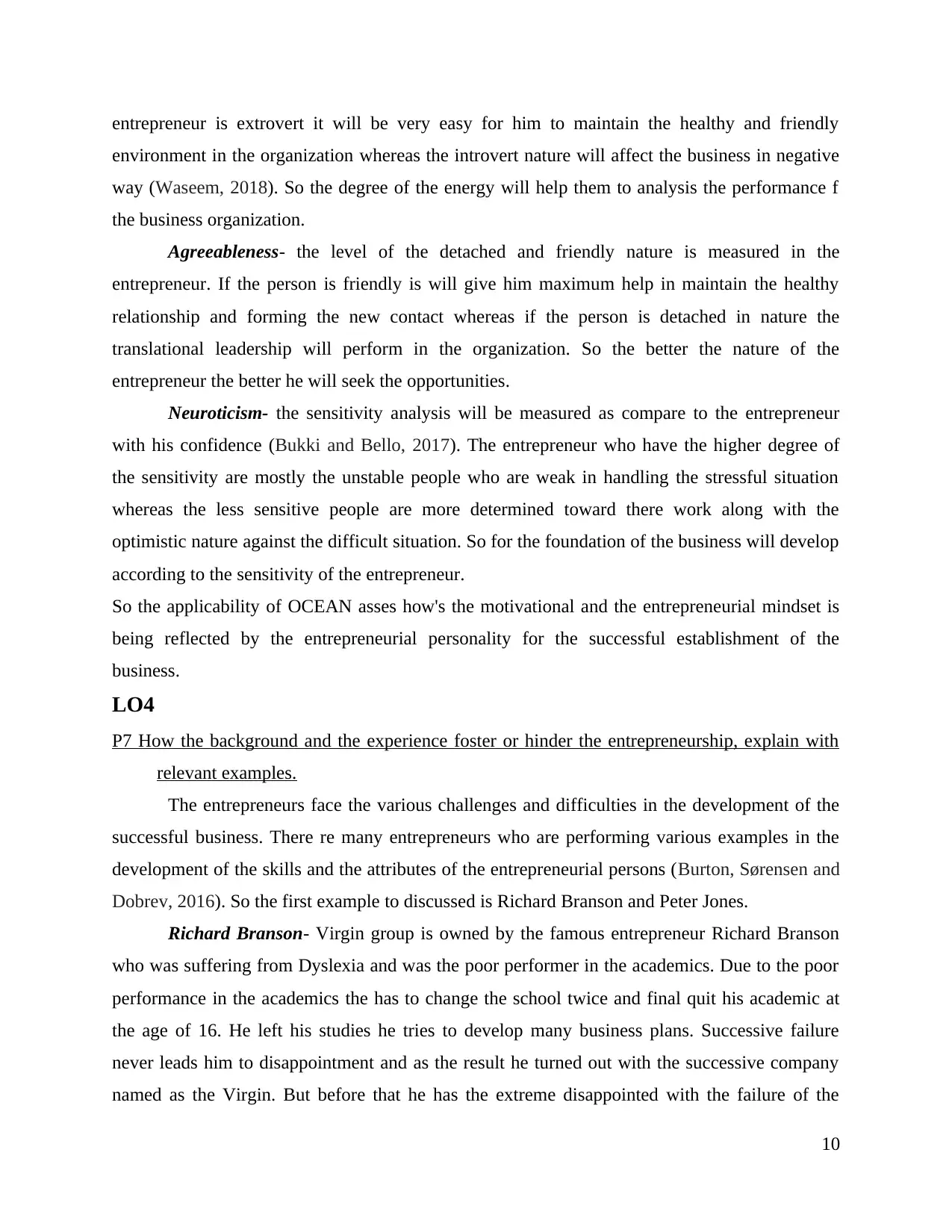
entrepreneur is extrovert it will be very easy for him to maintain the healthy and friendly
environment in the organization whereas the introvert nature will affect the business in negative
way (Waseem, 2018). So the degree of the energy will help them to analysis the performance f
the business organization.
Agreeableness- the level of the detached and friendly nature is measured in the
entrepreneur. If the person is friendly is will give him maximum help in maintain the healthy
relationship and forming the new contact whereas if the person is detached in nature the
translational leadership will perform in the organization. So the better the nature of the
entrepreneur the better he will seek the opportunities.
Neuroticism- the sensitivity analysis will be measured as compare to the entrepreneur
with his confidence (Bukki and Bello, 2017). The entrepreneur who have the higher degree of
the sensitivity are mostly the unstable people who are weak in handling the stressful situation
whereas the less sensitive people are more determined toward there work along with the
optimistic nature against the difficult situation. So for the foundation of the business will develop
according to the sensitivity of the entrepreneur.
So the applicability of OCEAN asses how's the motivational and the entrepreneurial mindset is
being reflected by the entrepreneurial personality for the successful establishment of the
business.
LO4
P7 How the background and the experience foster or hinder the entrepreneurship, explain with
relevant examples.
The entrepreneurs face the various challenges and difficulties in the development of the
successful business. There re many entrepreneurs who are performing various examples in the
development of the skills and the attributes of the entrepreneurial persons (Burton, Sørensen and
Dobrev, 2016). So the first example to discussed is Richard Branson and Peter Jones.
Richard Branson- Virgin group is owned by the famous entrepreneur Richard Branson
who was suffering from Dyslexia and was the poor performer in the academics. Due to the poor
performance in the academics the has to change the school twice and final quit his academic at
the age of 16. He left his studies he tries to develop many business plans. Successive failure
never leads him to disappointment and as the result he turned out with the successive company
named as the Virgin. But before that he has the extreme disappointed with the failure of the
10
environment in the organization whereas the introvert nature will affect the business in negative
way (Waseem, 2018). So the degree of the energy will help them to analysis the performance f
the business organization.
Agreeableness- the level of the detached and friendly nature is measured in the
entrepreneur. If the person is friendly is will give him maximum help in maintain the healthy
relationship and forming the new contact whereas if the person is detached in nature the
translational leadership will perform in the organization. So the better the nature of the
entrepreneur the better he will seek the opportunities.
Neuroticism- the sensitivity analysis will be measured as compare to the entrepreneur
with his confidence (Bukki and Bello, 2017). The entrepreneur who have the higher degree of
the sensitivity are mostly the unstable people who are weak in handling the stressful situation
whereas the less sensitive people are more determined toward there work along with the
optimistic nature against the difficult situation. So for the foundation of the business will develop
according to the sensitivity of the entrepreneur.
So the applicability of OCEAN asses how's the motivational and the entrepreneurial mindset is
being reflected by the entrepreneurial personality for the successful establishment of the
business.
LO4
P7 How the background and the experience foster or hinder the entrepreneurship, explain with
relevant examples.
The entrepreneurs face the various challenges and difficulties in the development of the
successful business. There re many entrepreneurs who are performing various examples in the
development of the skills and the attributes of the entrepreneurial persons (Burton, Sørensen and
Dobrev, 2016). So the first example to discussed is Richard Branson and Peter Jones.
Richard Branson- Virgin group is owned by the famous entrepreneur Richard Branson
who was suffering from Dyslexia and was the poor performer in the academics. Due to the poor
performance in the academics the has to change the school twice and final quit his academic at
the age of 16. He left his studies he tries to develop many business plans. Successive failure
never leads him to disappointment and as the result he turned out with the successive company
named as the Virgin. But before that he has the extreme disappointed with the failure of the
10
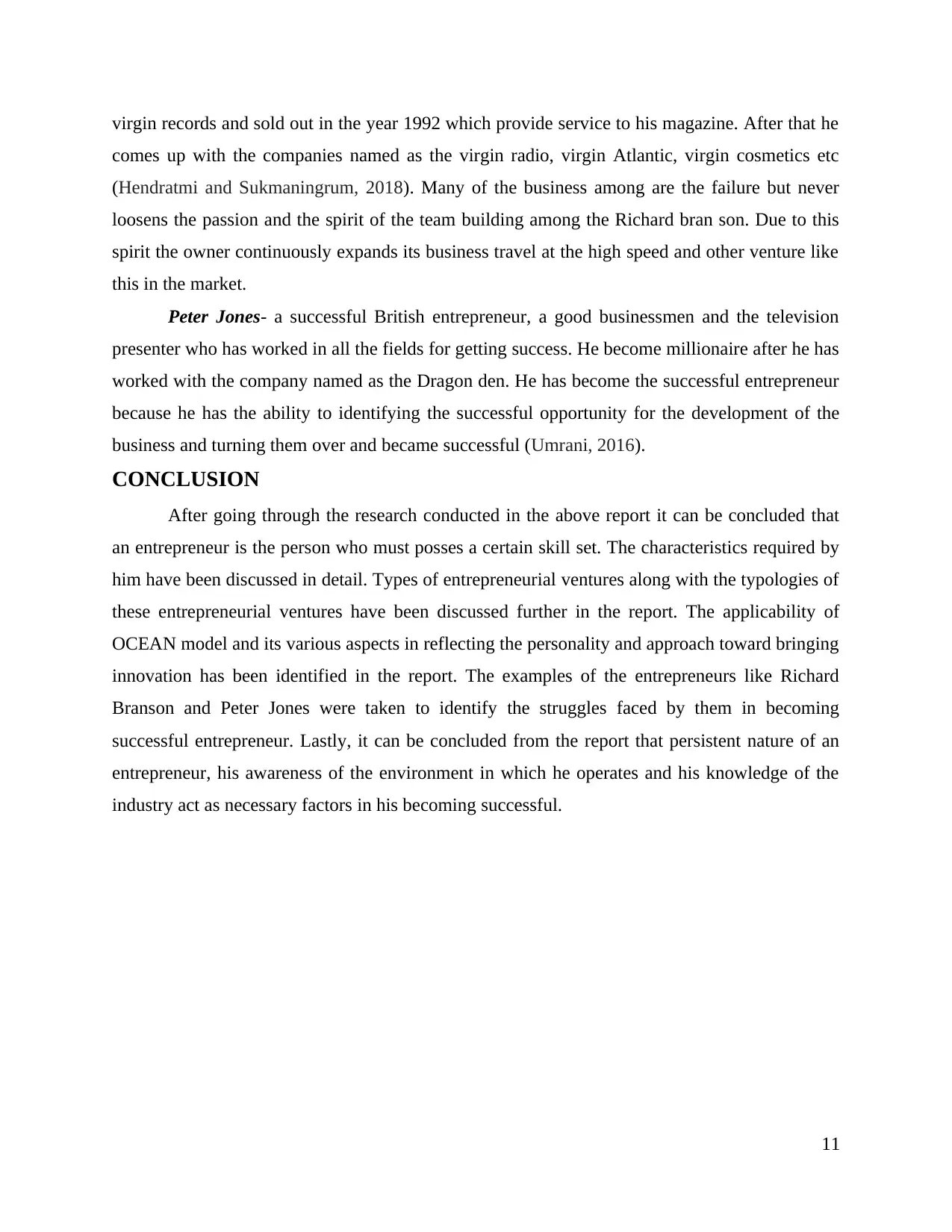
virgin records and sold out in the year 1992 which provide service to his magazine. After that he
comes up with the companies named as the virgin radio, virgin Atlantic, virgin cosmetics etc
(Hendratmi and Sukmaningrum, 2018). Many of the business among are the failure but never
loosens the passion and the spirit of the team building among the Richard bran son. Due to this
spirit the owner continuously expands its business travel at the high speed and other venture like
this in the market.
Peter Jones- a successful British entrepreneur, a good businessmen and the television
presenter who has worked in all the fields for getting success. He become millionaire after he has
worked with the company named as the Dragon den. He has become the successful entrepreneur
because he has the ability to identifying the successful opportunity for the development of the
business and turning them over and became successful (Umrani, 2016).
CONCLUSION
After going through the research conducted in the above report it can be concluded that
an entrepreneur is the person who must posses a certain skill set. The characteristics required by
him have been discussed in detail. Types of entrepreneurial ventures along with the typologies of
these entrepreneurial ventures have been discussed further in the report. The applicability of
OCEAN model and its various aspects in reflecting the personality and approach toward bringing
innovation has been identified in the report. The examples of the entrepreneurs like Richard
Branson and Peter Jones were taken to identify the struggles faced by them in becoming
successful entrepreneur. Lastly, it can be concluded from the report that persistent nature of an
entrepreneur, his awareness of the environment in which he operates and his knowledge of the
industry act as necessary factors in his becoming successful.
11
comes up with the companies named as the virgin radio, virgin Atlantic, virgin cosmetics etc
(Hendratmi and Sukmaningrum, 2018). Many of the business among are the failure but never
loosens the passion and the spirit of the team building among the Richard bran son. Due to this
spirit the owner continuously expands its business travel at the high speed and other venture like
this in the market.
Peter Jones- a successful British entrepreneur, a good businessmen and the television
presenter who has worked in all the fields for getting success. He become millionaire after he has
worked with the company named as the Dragon den. He has become the successful entrepreneur
because he has the ability to identifying the successful opportunity for the development of the
business and turning them over and became successful (Umrani, 2016).
CONCLUSION
After going through the research conducted in the above report it can be concluded that
an entrepreneur is the person who must posses a certain skill set. The characteristics required by
him have been discussed in detail. Types of entrepreneurial ventures along with the typologies of
these entrepreneurial ventures have been discussed further in the report. The applicability of
OCEAN model and its various aspects in reflecting the personality and approach toward bringing
innovation has been identified in the report. The examples of the entrepreneurs like Richard
Branson and Peter Jones were taken to identify the struggles faced by them in becoming
successful entrepreneur. Lastly, it can be concluded from the report that persistent nature of an
entrepreneur, his awareness of the environment in which he operates and his knowledge of the
industry act as necessary factors in his becoming successful.
11
Paraphrase This Document
Need a fresh take? Get an instant paraphrase of this document with our AI Paraphraser
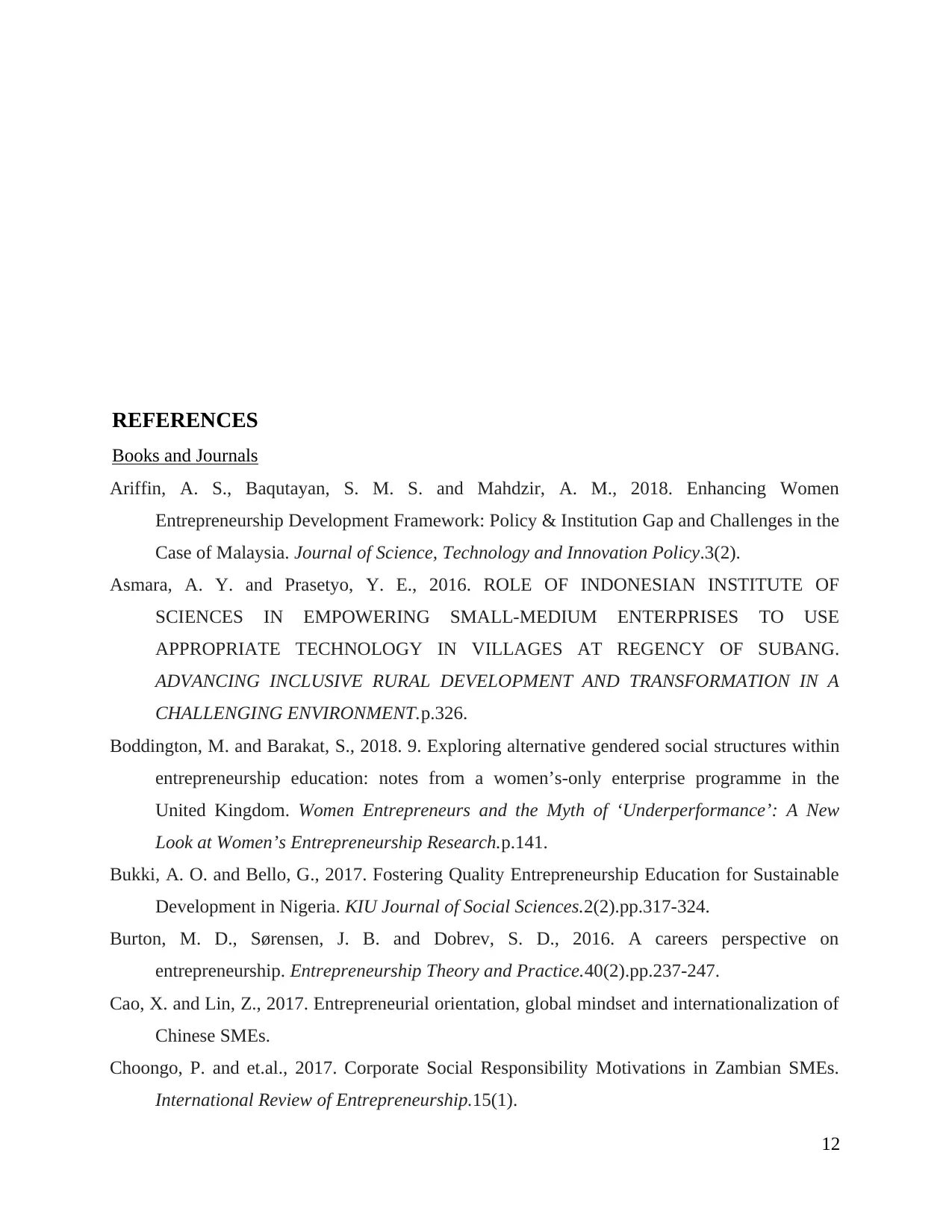
REFERENCES
Books and Journals
Ariffin, A. S., Baqutayan, S. M. S. and Mahdzir, A. M., 2018. Enhancing Women
Entrepreneurship Development Framework: Policy & Institution Gap and Challenges in the
Case of Malaysia. Journal of Science, Technology and Innovation Policy.3(2).
Asmara, A. Y. and Prasetyo, Y. E., 2016. ROLE OF INDONESIAN INSTITUTE OF
SCIENCES IN EMPOWERING SMALL-MEDIUM ENTERPRISES TO USE
APPROPRIATE TECHNOLOGY IN VILLAGES AT REGENCY OF SUBANG.
ADVANCING INCLUSIVE RURAL DEVELOPMENT AND TRANSFORMATION IN A
CHALLENGING ENVIRONMENT.p.326.
Boddington, M. and Barakat, S., 2018. 9. Exploring alternative gendered social structures within
entrepreneurship education: notes from a women’s-only enterprise programme in the
United Kingdom. Women Entrepreneurs and the Myth of ‘Underperformance’: A New
Look at Women’s Entrepreneurship Research.p.141.
Bukki, A. O. and Bello, G., 2017. Fostering Quality Entrepreneurship Education for Sustainable
Development in Nigeria. KIU Journal of Social Sciences.2(2).pp.317-324.
Burton, M. D., Sørensen, J. B. and Dobrev, S. D., 2016. A careers perspective on
entrepreneurship. Entrepreneurship Theory and Practice.40(2).pp.237-247.
Cao, X. and Lin, Z., 2017. Entrepreneurial orientation, global mindset and internationalization of
Chinese SMEs.
Choongo, P. and et.al., 2017. Corporate Social Responsibility Motivations in Zambian SMEs.
International Review of Entrepreneurship.15(1).
12
Books and Journals
Ariffin, A. S., Baqutayan, S. M. S. and Mahdzir, A. M., 2018. Enhancing Women
Entrepreneurship Development Framework: Policy & Institution Gap and Challenges in the
Case of Malaysia. Journal of Science, Technology and Innovation Policy.3(2).
Asmara, A. Y. and Prasetyo, Y. E., 2016. ROLE OF INDONESIAN INSTITUTE OF
SCIENCES IN EMPOWERING SMALL-MEDIUM ENTERPRISES TO USE
APPROPRIATE TECHNOLOGY IN VILLAGES AT REGENCY OF SUBANG.
ADVANCING INCLUSIVE RURAL DEVELOPMENT AND TRANSFORMATION IN A
CHALLENGING ENVIRONMENT.p.326.
Boddington, M. and Barakat, S., 2018. 9. Exploring alternative gendered social structures within
entrepreneurship education: notes from a women’s-only enterprise programme in the
United Kingdom. Women Entrepreneurs and the Myth of ‘Underperformance’: A New
Look at Women’s Entrepreneurship Research.p.141.
Bukki, A. O. and Bello, G., 2017. Fostering Quality Entrepreneurship Education for Sustainable
Development in Nigeria. KIU Journal of Social Sciences.2(2).pp.317-324.
Burton, M. D., Sørensen, J. B. and Dobrev, S. D., 2016. A careers perspective on
entrepreneurship. Entrepreneurship Theory and Practice.40(2).pp.237-247.
Cao, X. and Lin, Z., 2017. Entrepreneurial orientation, global mindset and internationalization of
Chinese SMEs.
Choongo, P. and et.al., 2017. Corporate Social Responsibility Motivations in Zambian SMEs.
International Review of Entrepreneurship.15(1).
12
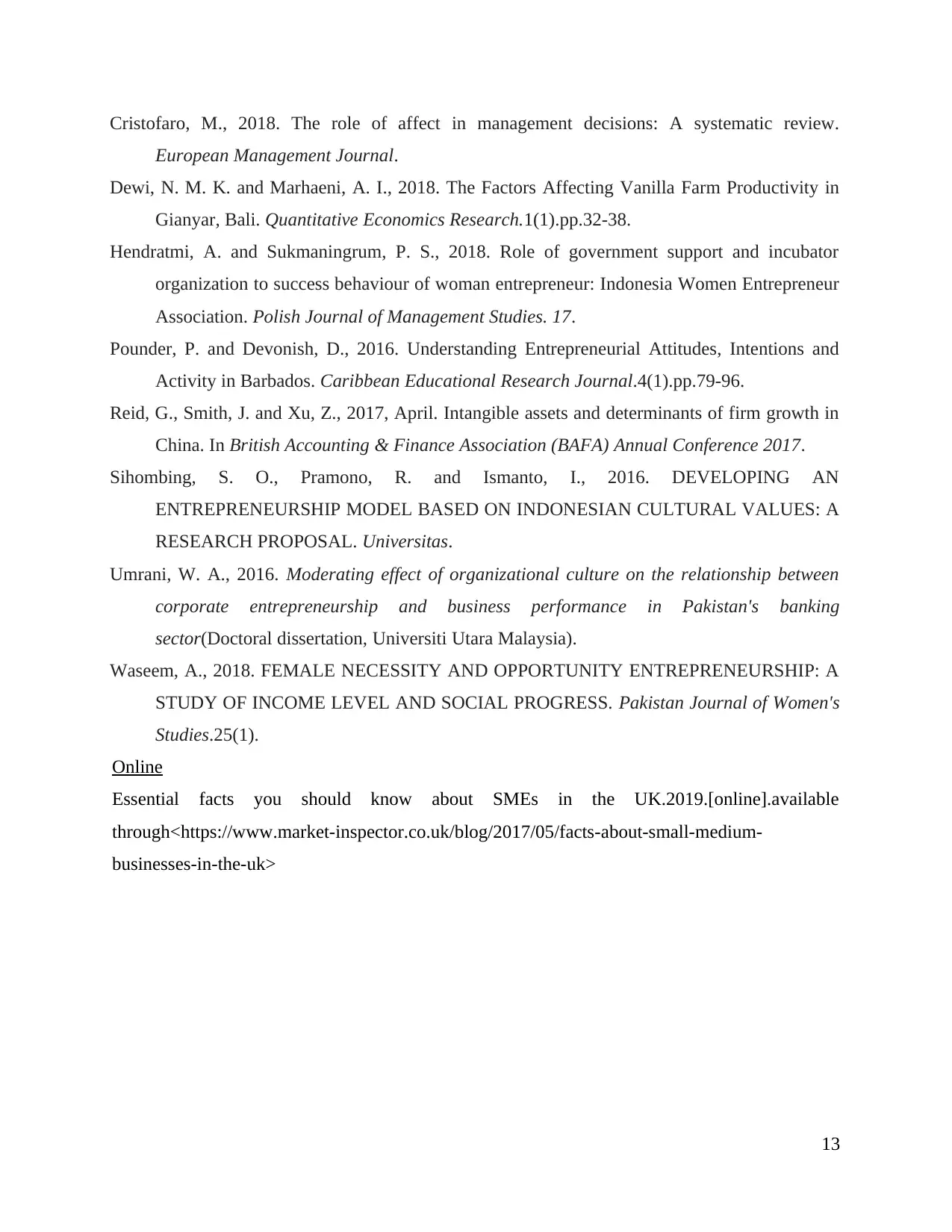
Cristofaro, M., 2018. The role of affect in management decisions: A systematic review.
European Management Journal.
Dewi, N. M. K. and Marhaeni, A. I., 2018. The Factors Affecting Vanilla Farm Productivity in
Gianyar, Bali. Quantitative Economics Research.1(1).pp.32-38.
Hendratmi, A. and Sukmaningrum, P. S., 2018. Role of government support and incubator
organization to success behaviour of woman entrepreneur: Indonesia Women Entrepreneur
Association. Polish Journal of Management Studies. 17.
Pounder, P. and Devonish, D., 2016. Understanding Entrepreneurial Attitudes, Intentions and
Activity in Barbados. Caribbean Educational Research Journal.4(1).pp.79-96.
Reid, G., Smith, J. and Xu, Z., 2017, April. Intangible assets and determinants of firm growth in
China. In British Accounting & Finance Association (BAFA) Annual Conference 2017.
Sihombing, S. O., Pramono, R. and Ismanto, I., 2016. DEVELOPING AN
ENTREPRENEURSHIP MODEL BASED ON INDONESIAN CULTURAL VALUES: A
RESEARCH PROPOSAL. Universitas.
Umrani, W. A., 2016. Moderating effect of organizational culture on the relationship between
corporate entrepreneurship and business performance in Pakistan's banking
sector(Doctoral dissertation, Universiti Utara Malaysia).
Waseem, A., 2018. FEMALE NECESSITY AND OPPORTUNITY ENTREPRENEURSHIP: A
STUDY OF INCOME LEVEL AND SOCIAL PROGRESS. Pakistan Journal of Women's
Studies.25(1).
Online
Essential facts you should know about SMEs in the UK.2019.[online].available
through<https://www.market-inspector.co.uk/blog/2017/05/facts-about-small-medium-
businesses-in-the-uk>
13
European Management Journal.
Dewi, N. M. K. and Marhaeni, A. I., 2018. The Factors Affecting Vanilla Farm Productivity in
Gianyar, Bali. Quantitative Economics Research.1(1).pp.32-38.
Hendratmi, A. and Sukmaningrum, P. S., 2018. Role of government support and incubator
organization to success behaviour of woman entrepreneur: Indonesia Women Entrepreneur
Association. Polish Journal of Management Studies. 17.
Pounder, P. and Devonish, D., 2016. Understanding Entrepreneurial Attitudes, Intentions and
Activity in Barbados. Caribbean Educational Research Journal.4(1).pp.79-96.
Reid, G., Smith, J. and Xu, Z., 2017, April. Intangible assets and determinants of firm growth in
China. In British Accounting & Finance Association (BAFA) Annual Conference 2017.
Sihombing, S. O., Pramono, R. and Ismanto, I., 2016. DEVELOPING AN
ENTREPRENEURSHIP MODEL BASED ON INDONESIAN CULTURAL VALUES: A
RESEARCH PROPOSAL. Universitas.
Umrani, W. A., 2016. Moderating effect of organizational culture on the relationship between
corporate entrepreneurship and business performance in Pakistan's banking
sector(Doctoral dissertation, Universiti Utara Malaysia).
Waseem, A., 2018. FEMALE NECESSITY AND OPPORTUNITY ENTREPRENEURSHIP: A
STUDY OF INCOME LEVEL AND SOCIAL PROGRESS. Pakistan Journal of Women's
Studies.25(1).
Online
Essential facts you should know about SMEs in the UK.2019.[online].available
through<https://www.market-inspector.co.uk/blog/2017/05/facts-about-small-medium-
businesses-in-the-uk>
13
1 out of 15
Related Documents
Your All-in-One AI-Powered Toolkit for Academic Success.
+13062052269
info@desklib.com
Available 24*7 on WhatsApp / Email
![[object Object]](/_next/static/media/star-bottom.7253800d.svg)
Unlock your academic potential
© 2024 | Zucol Services PVT LTD | All rights reserved.





